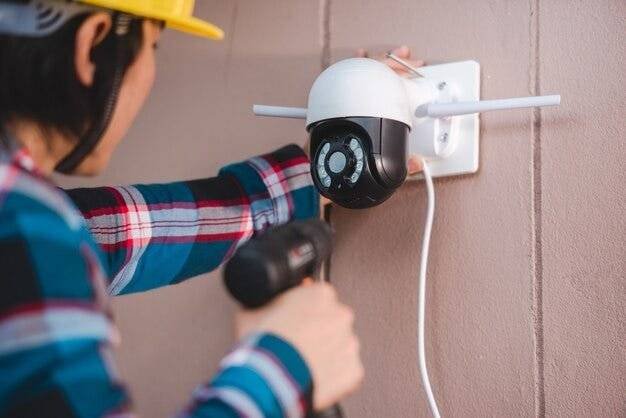Configuring and installing a CCTV system
Configuring a CCTV (Closed-Circuit Television) system involves several steps, including planning, installation, and setup. Here's a step-by-step guide to help you through the process:
Read More
1. Planning
Assess Your Needs:- Determine the purpose of the CCTV system (e.g., security, monitoring).
- Identify the areas you want to monitor.
- Choose the type of cameras (e.g., dome, bullet, PTZ).
- Decide on the resolution and features (e.g., night vision, motion detection).
- Choose between wired and wireless systems.
- Select a DVR (Digital Video Recorder) or NVR (Network Video Recorder) based on your camera type.
2. Installation
Mount the Cameras:- Position the cameras to cover the desired areas.
- Use appropriate mounts and brackets.
- Ensure the cameras are protected from weather and vandalism if installed outdoors.
- For wired systems, run the cables from the cameras to the recording device.
- Use conduit or cable clips to secure the cables.
- Ensure the cables are hidden to avoid tampering.
- Connect the cameras to the DVR/NVR using BNC cables (for analog cameras) or Ethernet cables (for IP cameras).
- Connect power supplies to the cameras if they are not PoE (Power over Ethernet).
- Place the DVR/NVR in a secure location.
- Connect the DVR/NVR to a monitor and a power source.
- Connect the DVR/NVR to your network for remote access.
3. Configuration
Initial Setup:- Power on the DVR/NVR and monitor.
- Follow the on-screen prompts to set up the device (e.g., date and time, language).
- Add cameras to the DVR/NVR.
- Adjust camera settings (e.g., resolution, frame rate, recording schedule).
- Set up motion detection zones and sensitivity if available.
- Assign a static IP address to the DVR/NVR.
- Configure port forwarding on your router for remote access.
- Use the manufacturer's app or software to access the CCTV system remotely.
- Check all camera feeds to ensure they are working correctly.
- Test the recording and playback functions.
- Verify remote access through a smartphone or computer.
4. Maintenance
Regular Checks:- Periodically check camera angles and adjust if necessary.
- Clean camera lenses to ensure clear images.
- Check for firmware updates for the DVR/NVR and cameras.
- Monitor storage capacity and manage recordings.
- Set up automatic overwrite for old recordings if needed.
- Change default passwords to secure the system.
- Keep the firmware updated to protect against vulnerabilities.
Tips:
- Label cables during installation to avoid confusion.
- Consider using a UPS (Uninterruptible Power Supply) to protect the system from power outages.
- Regularly back up important footage.
Advanced Configuration
Camera Settings
Field of View and Placement:- Use wide-angle lenses for larger areas and narrow-angle lenses for focused monitoring.
- Place cameras at optimal heights to avoid blind spots.
- Adjust brightness, contrast, and color settings for clear images.
- Use the highest resolution settings supported by your DVR/NVR to ensure detailed footage.
- Enable infrared (IR) settings for night vision.
- Ensure no obstructions block the IR LEDs.
Recording and Storage
Recording Modes:- Continuous Recording: Records all the time, ensuring no event is missed.
- Motion Detection: Records only when motion is detected, saving storage space.
- Scheduled Recording: Records based on a preset schedule.
- Internal HDD: Ensure you have sufficient capacity for your needs.
- Network Storage: Use NAS (Network Attached Storage) for additional storage.
- Cloud Storage: Some systems offer cloud storage options for remote backup.
Remote Access
Mobile App Configuration:- Download the app provided by your CCTV manufacturer.
- Scan the QR code on the DVR/NVR to add the device to the app.
- Configure notifications for motion detection or other events.
- Access the DVR/NVR through a web browser by entering its IP address.
- Ensure your router's port forwarding is correctly set up for external access.
- Create different user accounts with varied permissions for family members or employees.
- Regularly update passwords and use strong, unique passwords for security.
Troubleshooting
Common Issues:- No Video Signal:
- Check power connections and ensure the camera is receiving power.
- Verify cable connections and check for any damage.
- Restart the DVR/NVR and cameras.
- Poor Image Quality:
- Clean the camera lens.
- Adjust focus and lens settings.
- Check the resolution and bitrate settings.
- Remote Access Issues:
- Ensure the DVR/NVR is connected to the internet.
- Verify port forwarding settings.
- Check firewall settings on the router and DVR/NVR.
- Intermittent Recording:
- Check motion detection settings and sensitivity.
- Ensure sufficient storage space is available.
- Verify recording schedule settings.
Optimization Tips
Coverage and Blind Spots:- Use overlapping camera views to cover blind spots.
- Utilize PTZ (Pan-Tilt-Zoom) cameras for large areas and adjust them to monitor different zones.
- Ensure proper lighting for clear images, especially in areas without night vision.
- Avoid direct sunlight or bright lights directly into the camera lens.
- Schedule regular checks and cleaning for cameras.
- Test the system periodically to ensure all components are functioning correctly.
- Implement a backup solution for critical footage.
- Regularly check backup storage to ensure data integrity.
- Regularly update firmware for cameras and DVR/NVR to enhance security and functionality.
- Update mobile apps and monitoring software to the latest versions.
- Change default login credentials immediately after installation.
- Use encryption for video streams if supported.
- Disable unused network services and ports.
Additional Features
Integration with Other Systems:- Integrate CCTV with alarm systems for enhanced security.
- Use smart home integrations for automated responses to detected events.
- Utilize built-in analytics for advanced features like facial recognition, object tracking, or license plate recognition.
- Adjust analytics settings to reduce false alarms and improve accuracy.
- Combine CCTV with access control systems to monitor and control entry points.
- Use video intercom systems for enhanced security at entrances.
Final Checklist
- System Design:
- Ensure the system design meets your coverage and monitoring needs.
- Installation:
- Verify all cameras and cables are securely installed and connected.
- Configuration:
- Test and configure all cameras and settings.
- Testing:
- Conduct thorough testing of recording, playback, and remote access functions.
- Security:
- Secure the system with strong passwords and updated firmware.




